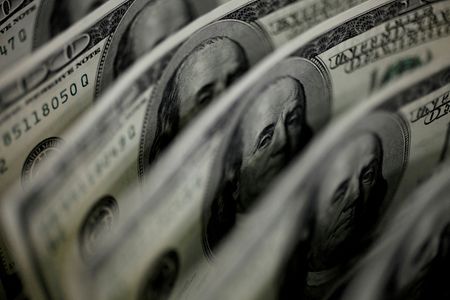By Saqib Iqbal Ahmed
NEW YORK (Reuters) -Investors are hesitant to bet on a sustained decline in the dollar, even after the U.S. currency suffered its sharpest pullback in about 15 months and a potentially pivotal Federal Reserve meeting looms.
During the recent dip in the U.S. Dollar Index, the greenback has fallen by as much as 4.6% from a two-decade high of 114.778 hit in late September, the largest retreat from a 52-week high since July 2021. At the same time, the crowd of dollar bulls has thinned; net bets on a higher dollar stood at $11.3 billion in futures markets, their lowest level since March, the latest data from the U.S. Commodity Futures Trading Commission showed.
A reversal of the dollar’s rally – in which it has risen by 20% over the last 20 months – would likely come as a relief to everyone from U.S. corporations to global central banks such as the Bank of Japan, which spent $43 billion in foreign exchange markets last month to shore up the plummeting yen.
Still, many investors believe the conditions are not yet in place for an extended dollar downtrend, partially because U.S. rates are likely to stay above those in other developed economies for the time being. A less hawkish-than-expected message from the Fed at Wednesday’s monetary policy meeting, however, could exacerbate the currency’s recent decline.
“I think it is more of a speed bump rather than a turnaround,” said Jason Draho, head of asset allocation Americas at UBS Global Wealth Management.
A hawkish Fed, Europe’s energy crisis, political upheaval in Britain and the Bank of Japan’s dovish monetary policy have all contributed to the dollar’s rally this year. More recently, however, European gas prices have eased, bolstering the euro, and a change of government in Britain has helped stabilize the pound.
The dollar’s pullback has also coincided with a broad rally in U.S. stocks and Treasuries driven in part by hopes that the Fed may slow its monetary policy tightening. The Fed has raised rates by 300 basis points this year, bruising equities and debt markets but boosting the dollar’s appeal in relation to other currencies.
Still, betting that the Fed will ease up on its fight against inflation has been a dangerous undertaking this year. That has made investors like Paresh Upadhyaya, director of fixed income and currency strategy at Amundi US, wary of calling an end to the dollar rally.
“We have seen this at least three times over the last six months where the market is anticipating the vaunted Fed pivot only to get disappointed,” he said.
Investors expect the Federal Reserve to boost interest rates by another 75 basis points on Wednesday and will be listening for clues on whether it plans to slow the pace of its rate hikes in coming months.
Signs of a less hawkish Fed could spark a 1-2% pullback in the dollar, but such a move would likely be short-lived, said Brad Bechtel, global head of FX at Jefferies.
“The Fed will still be hiking and in terms of the overnight rate, it is still one of the highest in the G10,” said Bechtel, who expects the dollar to strengthen into year-end.
At the same time, a Fed that is slowing the pace of monetary tightening could encourage other central banks to do the same, allowing the United States to maintain the comparatively higher yields that have burnished the dollar’s allure. Some central banks have already delivered smaller than expected rate increases in recent weeks, including the Bank of Canada and Reserve Bank of Australia.
“If the Fed pulls back that will allow (other central banks) to pull back as well,” said UBS’s Draho, who expects more dollar strength in coming months.
WINTER IS COMING
There are factors that could hurt the bullish case for the dollar. Signs of a rapid decline in U.S. inflation or a sharp economic downturn could undercut the case for monetary tightening and potentially weigh on the greenback.
Energy prices in Europe may prove to be a particularly important factor in determining whether the euro can hold on to its recent gains against the U.S. currency, said Ugo Lancioni, head of currency management at Neuberger Berman.
“So far the weather has been very mild in Europe. Winter is obviously going to come and the question is whether prices can stay down here,” said Lancioni.
Still, with the dollar near a 20-year high, further dollar gains are likely to be accompanied by increased volatility, analysts said.
“I think we are entering a more two-way market,” Lancioni said.
(Reporting by Saqib Iqbal Ahmed in New YorkEditing by Ira Iosebashvili and Matthew Lewis)

